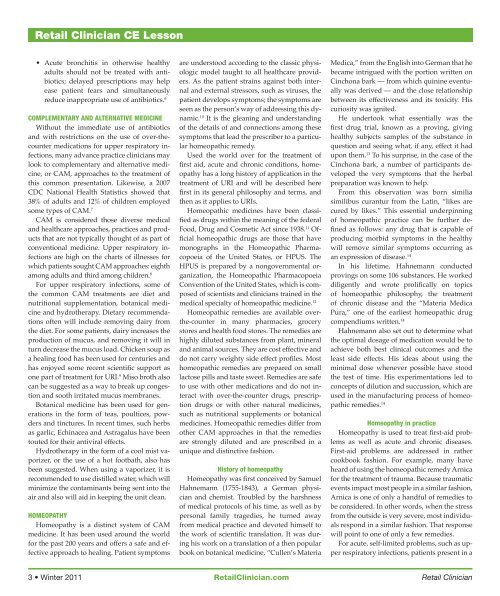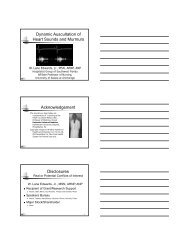the homeopathic treatment of upper respiratory infections
the homeopathic treatment of upper respiratory infections
the homeopathic treatment of upper respiratory infections
Create successful ePaper yourself
Turn your PDF publications into a flip-book with our unique Google optimized e-Paper software.
Retail Clinician CE Lesson• Acute bronchitis in o<strong>the</strong>rwise healthyadults should not be treated with antibiotics;delayed prescriptions may helpease patient fears and simultaneouslyreduce inappropriate use <strong>of</strong> antibiotics. 6Complementary and alternative medicineWithout <strong>the</strong> immediate use <strong>of</strong> antibioticsand with restrictions on <strong>the</strong> use <strong>of</strong> over-<strong>the</strong>countermedications for <strong>upper</strong> <strong>respiratory</strong> <strong>infections</strong>,many advance practice clinicians maylook to complementary and alternative medicine,or CAM, approaches to <strong>the</strong> <strong>treatment</strong> <strong>of</strong>this common presentation. Likewise, a 2007CDC National Health Statistics showed that38% <strong>of</strong> adults and 12% <strong>of</strong> children employedsome types <strong>of</strong> CAM. 7CAM is considered those diverse medicaland healthcare approaches, practices and productsthat are not typically thought <strong>of</strong> as part <strong>of</strong>conventional medicine. Upper <strong>respiratory</strong> <strong>infections</strong>are high on <strong>the</strong> charts <strong>of</strong> illnesses forwhich patients sought CAM approaches: eighthamong adults and third among children. 8For <strong>upper</strong> <strong>respiratory</strong> <strong>infections</strong>, some <strong>of</strong><strong>the</strong> common CAM <strong>treatment</strong>s are diet andnutritional supplementation, botanical medicineand hydro<strong>the</strong>rapy. Dietary recommendations<strong>of</strong>ten will include removing dairy from<strong>the</strong> diet. For some patients, dairy increases <strong>the</strong>production <strong>of</strong> mucus, and removing it will inturn decrease <strong>the</strong> mucus load. Chicken soup asa healing food has been used for centuries andhas enjoyed some recent scientific support asone part <strong>of</strong> <strong>treatment</strong> for URI. 9 Miso broth alsocan be suggested as a way to break up congestionand sooth irritated mucus membranes.Botanical medicine has been used for generationsin <strong>the</strong> form <strong>of</strong> teas, poultices, powdersand tinctures. In recent times, such herbsas garlic, Echinacea and Astragalus have beentouted for <strong>the</strong>ir antiviral effects.Hydro<strong>the</strong>rapy in <strong>the</strong> form <strong>of</strong> a cool mist vaporizer,or <strong>the</strong> use <strong>of</strong> a hot footbath, also hasbeen suggested. When using a vaporizer, it isrecommended to use distilled water, which willminimize <strong>the</strong> contaminants being sent into <strong>the</strong>air and also will aid in keeping <strong>the</strong> unit clean.HomeopathyHomeopathy is a distinct system <strong>of</strong> CAMmedicine. It has been used around <strong>the</strong> worldfor <strong>the</strong> past 200 years and <strong>of</strong>fers a safe and effectiveapproach to healing. Patient symptomsare understood according to <strong>the</strong> classic physiologicmodel taught to all healthcare providers.As <strong>the</strong> patient strains against both internaland external stressors, such as viruses, <strong>the</strong>patient develops symptoms; <strong>the</strong> symptoms areseen as <strong>the</strong> person’s way <strong>of</strong> addressing this dynamic.10 It is <strong>the</strong> gleaning and understanding<strong>of</strong> <strong>the</strong> details <strong>of</strong> and connections among <strong>the</strong>sesymptoms that lead <strong>the</strong> prescriber to a particular<strong>homeopathic</strong> remedy.Used <strong>the</strong> world over for <strong>the</strong> <strong>treatment</strong> <strong>of</strong>first aid, acute and chronic conditions, homeopathyhas a long history <strong>of</strong> application in <strong>the</strong><strong>treatment</strong> <strong>of</strong> URI and will be described herefirst in its general philosophy and terms, and<strong>the</strong>n as it applies to URIs.Homeopathic medicines have been classifiedas drugs within <strong>the</strong> meaning <strong>of</strong> <strong>the</strong> federalFood, Drug and Cosmetic Act since 1938. 11 Official<strong>homeopathic</strong> drugs are those that havemonographs in <strong>the</strong> Homeopathic Pharmacopoeia<strong>of</strong> <strong>the</strong> United States, or HPUS. TheHPUS is prepared by a nongovernmental organization,<strong>the</strong> Homeopathic PharmacopoeiaConvention <strong>of</strong> <strong>the</strong> United States, which is composed<strong>of</strong> scientists and clinicians trained in <strong>the</strong>medical specialty <strong>of</strong> <strong>homeopathic</strong> medicine. 12Homeopathic remedies are available over<strong>the</strong>-counterin many pharmacies, grocerystores and health food stores. The remedies arehighly diluted substances from plant, mineraland animal sources. They are cost effective anddo not carry weighty side effect pr<strong>of</strong>iles. Most<strong>homeopathic</strong> remedies are prepared on smalllactose pills and taste sweet. Remedies are safeto use with o<strong>the</strong>r medications and do not interactwith over-<strong>the</strong>-counter drugs, prescriptiondrugs or with o<strong>the</strong>r natural medicines,such as nutritional supplements or botanicalmedicines. Homeopathic remedies differ fromo<strong>the</strong>r CAM approaches in that <strong>the</strong> remediesare strongly diluted and are prescribed in aunique and distinctive fashion.History <strong>of</strong> homeopathyHomeopathy was first conceived by SamuelHahnemann (1755-1843), a German physicianand chemist. Troubled by <strong>the</strong> harshness<strong>of</strong> medical protocols <strong>of</strong> his time, as well as bypersonal family tragedies, he turned awayfrom medical practice and devoted himself to<strong>the</strong> work <strong>of</strong> scientific translation. It was duringhis work on a translation <strong>of</strong> a <strong>the</strong>n popularbook on botanical medicine, “Cullen’s MateriaMedica,” from <strong>the</strong> English into German that hebecame intrigued with <strong>the</strong> portion written onCinchona bark — from which quinine eventuallywas derived — and <strong>the</strong> close relationshipbetween its effectiveness and its toxicity. Hiscuriosity was ignited.He undertook what essentially was <strong>the</strong>first drug trial, known as a proving, givinghealthy subjects samples <strong>of</strong> <strong>the</strong> substance inquestion and seeing what, if any, effect it hadupon <strong>the</strong>m. 13 To his surprise, in <strong>the</strong> case <strong>of</strong> <strong>the</strong>Cinchona bark, a number <strong>of</strong> participants developed<strong>the</strong> very symptoms that <strong>the</strong> herbalpreparation was known to help.From this observation was born similiasimilibus curantur from <strong>the</strong> Latin, “likes arecured by likes.” This essential underpinning<strong>of</strong> <strong>homeopathic</strong> practice can be fur<strong>the</strong>r definedas follows: any drug that is capable <strong>of</strong>producing morbid symptoms in <strong>the</strong> healthywill remove similar symptoms occurring asan expression <strong>of</strong> disease. 14In his lifetime, Hahnemann conductedprovings on some 106 substances. He workeddiligently and wrote prolifically on topics<strong>of</strong> <strong>homeopathic</strong> philosophy, <strong>the</strong> <strong>treatment</strong><strong>of</strong> chronic disease and <strong>the</strong> “Materia MedicaPura,” one <strong>of</strong> <strong>the</strong> earliest <strong>homeopathic</strong> drugcompendiums written. 14Hahnemann also set out to determine what<strong>the</strong> optimal dosage <strong>of</strong> medication would be toachieve both best clinical outcomes and <strong>the</strong>least side effects. His ideas about using <strong>the</strong>minimal dose whenever possible have stood<strong>the</strong> test <strong>of</strong> time. His experimentations led toconcepts <strong>of</strong> dilution and succussion, which areused in <strong>the</strong> manufacturing process <strong>of</strong> <strong>homeopathic</strong>remedies. 14Homeopathy in practiceHomeopathy is used to treat first-aid problemsas well as acute and chronic diseases.First-aid problems are addressed in ra<strong>the</strong>rcookbook fashion. For example, many haveheard <strong>of</strong> using <strong>the</strong> <strong>homeopathic</strong> remedy Arnicafor <strong>the</strong> <strong>treatment</strong> <strong>of</strong> trauma. Because traumaticevents impact most people in a similar fashion,Arnica is one <strong>of</strong> only a handful <strong>of</strong> remedies tobe considered. In o<strong>the</strong>r words, when <strong>the</strong> stressfrom <strong>the</strong> outside is very severe, most individualsrespond in a similar fashion. That responsewill point to one <strong>of</strong> only a few remedies.For acute, self-limited problems, such as <strong>upper</strong><strong>respiratory</strong> <strong>infections</strong>, patients present in a3 • Winter 2011 RetailClinician.com Retail Clinician





